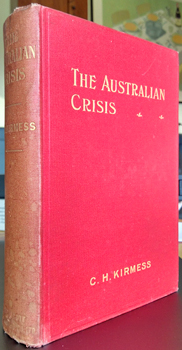
KIRMESS, C.H. [i.e. Frank Fox?]. The Australian Crisis. London, Walter Scott 1909. Octavo red cloth (spine faded and a bit rubbed); 336pp. Cheap endpapers browned, some minor signs of use but a pretty good copy. Au$150
First edition. One of the classic yellow peril novels, this chronicles - from 1922 looking back to 1912 - the Japanese invasion of Australia - first by wile and cunnning then by war. It is of course a bit more complex, there is social turmoil and political breakdown, civil war and the abandonment, if not betrayal, of Australia by Britain. The central section of the book is the romance of the White Guard - the volunteer militia - and their guerilla warfare against the Japanese in the Northern Territory.
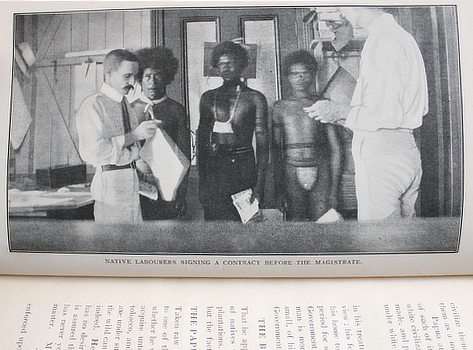
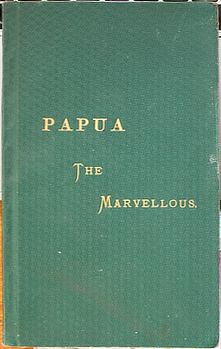
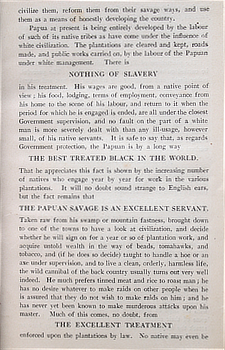

Papua the Marvellous. The country of chances. [Melbourne, Govt Printer [1910?]. Octavo publisher's flush cut cloth; 52pp and 10 photo plates. A read but decent enough copy. Au$175
A superbly concise lesson in how to pillage a country and exploit a people, with little capital and a healthy profit. No more exterminating the natives "as a simple matter of ordinary routine," nor even are tribes now "spared, but enslaved". The modern ruler civilizes, reforms and uses them for "honestly developing the country." It won't be long before the "cannibals of the west will be almost worth their weight in gold."
Australia was still the new owner of its very own colony. A few more years brought German New Guinea as a war prize and proper large scale corruption but in the meantime, with a few hundred quid and a bit of nous, a bloke could do pretty well.
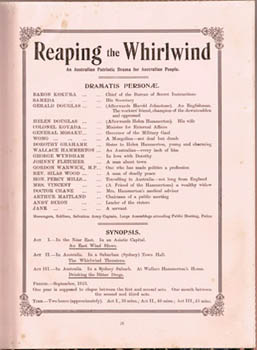
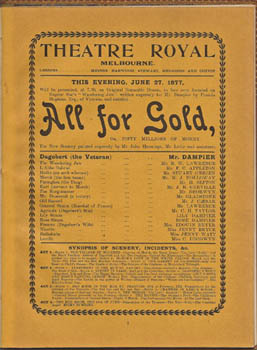



HOPKINS, Francis R.C. Souvenir of the Dramatic Works. Printed for private circulation only. Sydney 1910. Large octavo publisher's red morocco (edges rubbed); [7],32pp, photo illustrations & facsimile playbills on various coloured papers. Some unnecessary annotations on the last couple of pages by an intermediate owner. Au$300
Inscribed by Hopkins to A.B. Triggs. The synopsis and playbills for William Dampier's productions of Hopkins' plays from 'Good For Evil' (1876) to his yellow peril romp, 'Reaping the Whirlwind' - published in 1909 but despite the mock playbill here, never produced.
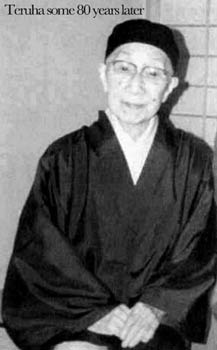
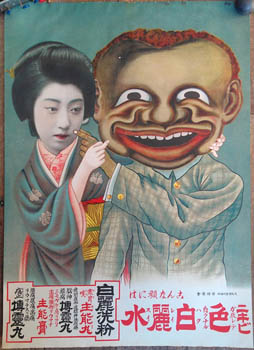

Teruha toiletry poster. [Hakuresui or Hakureisui]. A shop poster for Hakuresui toiletry to whiten the skin and remove blemishes. Osaka, Takegaki Shokai c1910. Colour lithograph 53x38cm on quite heavy paper. A couple of tiny edge chips, a near invisible repair to a short tear; a rather good copy. Au$1200
Among the myriad images that use race superiority and fear to sell goods - particularly soaps, toiletries and cosmetics - this is the weirdest and most hypnotic that I've ever seen. The weirdness intensifies if you know that the model is Teruha, maybe Japan's most famous geisha and pin-up girl at the end of the Meiji and through the Taisho period. Born Tatsuko Takaoka, in this poster she is about 14 and has possibly graduated from her apprentice name, Chiyoha. Sold by her father at 12, her virginity was soon sold to the president of the Osaka stock exchange and by the time she was 14 she had been engaged to one wealthy business man, promised to another and had a secret affair with an actor. The extended left pinkie finger must be a joke about her misguided sacrifice to love which earnt her yet another name: the Nine Fingered Geisha.
Before and after - or with and without - comparisons were nothing new in Japanese advertising. Neither were celebrities: courtesan prints sold patent medicines long before the Americans arrived and Bismarck adorned adverts for a patent syphilis cure that did for medicine what Bismarck did for Germany. Darkie - coon, nigger, whatever you want to call it - advertising images were obviously not unknown but neither can they have been familiar enough to be taken for granted and reproduced to the American and British formula in the way that the jazz age negro became a standard pattern to be played with by artists and designers in Japan as everywhere else. There is more than hint of a jovial jokai, tengu, spirit or minor god here, but for that suit.
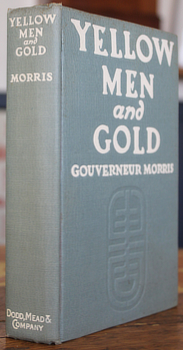
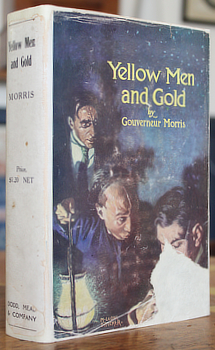
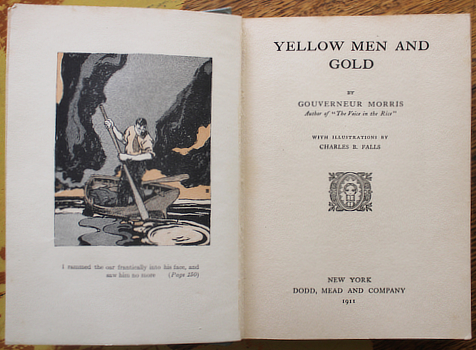

MORRIS, Gouverneur. Yellow Men and Gold. NY, Dodd Mead 1911. Octavo publisher's cloth blocked in white and blind; illustrated dustwrapper with a large piece gone from the front, professionally repaired by the look of it around the edges; six duotone plates, smaller illustrations by Charles Falls. A rather good copy. Au$300
First edition of this rip-roaring thriller in which the Yellow Men are not the malevolent peril but brave, stalwart and devoted to their elected captain Bessie who, it is suggested, has a touch of Africa in her veins. Still, despite the shocking reversal of roles in a thriller of the period, there's more than enough racism to go round. Or as any character might say, "Plentee dam lacist."
The wimp in glasses on the dustwrapper looks quite like Morris.
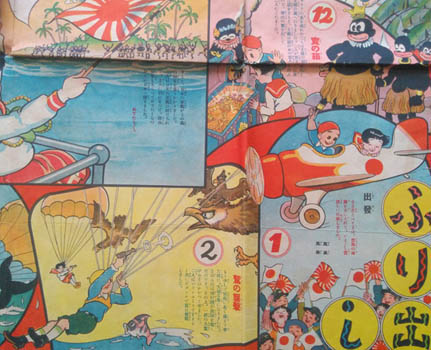
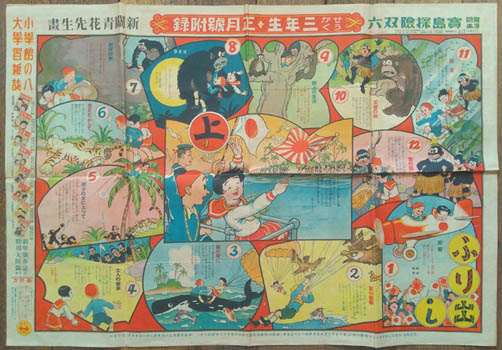
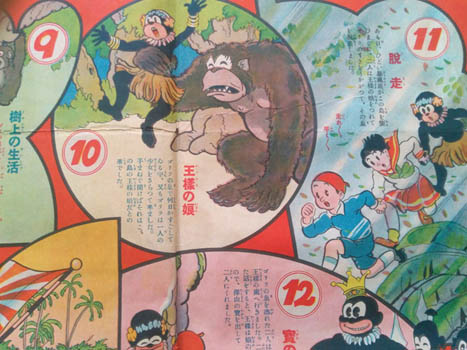
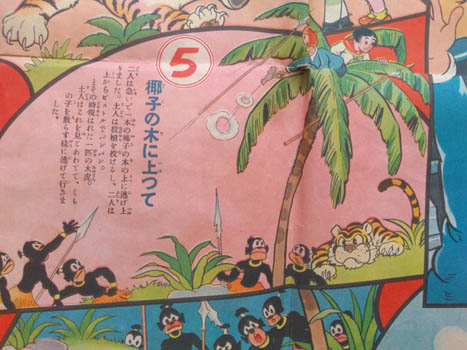

Niizeki Kennosuke (?) [Boken Manga Takarajima Tanken Sugoroku]. Tokyo, Shogakukan 1935 (Showa 10). Colour broadside 54x78cm. A bit used: rumpled with some short tears in folds. Not bad. Au$325
This exciting adventure with the natives, giant apes and tigers of a coral island was the new year gift from the Shogaku magazine for third graders. An exemplary lesson as to why every eight year old should be issued a service revolver before they leave the house.

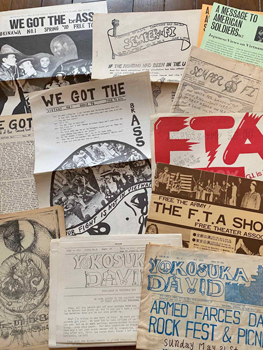
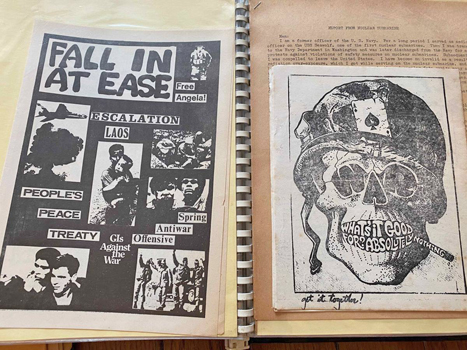
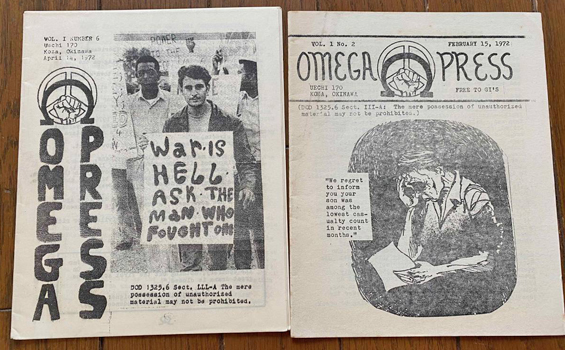

Vietnam: anti war and underground American press in Japan. A collection of newspapers and leaflets produced by or for the American military in Japan during the Vietnam war. vp (Okinawa, Iwakuni, Yokosuka, Tokyo &c) vd c1969-74, mostly 1970 to 1972. 71 items in two old folders (plus a few duplicates) of various sizes on various papers ranging from the clumsiest mimeograph leaf to reasonably well printed offset - most down the lower end of the production scale - many illustrated with varied success by photo or drawing. The condition ranges from shabby but complete to fresh off the press - mostly up the top end of the condition scale. Au$3500
A splendid collection made by someone who must have been involved in the production of some of these ephemeral outcries. I suspect a member of the Beheiren - the loose organisation of Japanese opponents to the Vietnam war: on one Beheiren piece the address and phone numbers have been updated by hand; with another, three fresh copies on different colour paper have been preserved. There are annotations here and there in English and a few in Japanese.
There may be a more complete collection of these things somewhere in the world but I haven't found it. I thought the Wisconsin Historical Society GI Press collection was such a place until I discovered that it is a digital collection scanned from pieces all over the world by the dedicated academic James Lewes. He didn't find quite a few things that are here.
Titles include Semper Fi; We Got the brASS; Yokosuka David; GI Free Press Okinawa; Fall In at Ease; Demand for Freedom; GI Newsletter; the 1st Amendment; Omega Press; Freedom of the Press.
Most of these say adamantly that the authorities were not allowed to confiscate them; I wonder how that worked in practice.
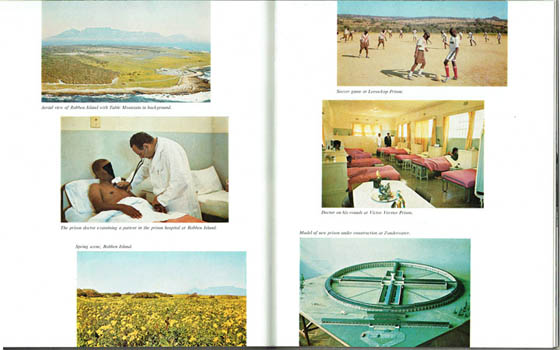
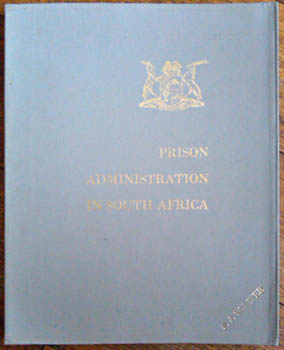


Prison Administration in South Africa. Department of Foreign Affairs [1969]. Quarto, excellent in publisher's gilt stamped limp leatherette; [6],46pp and numerous photo illustrations (some colour). Au$150
The Prime Minister's copy, stamped "B.J. Vorster" on the front cover, of this model for beleaguered governments. Significant here is that it was only the South African Foreign Department, not those directly responsible for prisons, that felt the need to respond to growing international condemnation.
The United Nations resolution of 1968 condemned South Africa so this report was delivered to the United Nations with a defiant letter stating that the UN had no competence to criticise prison management (cf Horrell; Survey of Race Relations in South Africa 1969). One section addresses the "attempts to discredit the South African prison system" and implicit in the photographs of healthy young black African men being taught trades and cared for by older and wiser white men in clean modern facilities is that any complaint by them would be unforgivable ingratitude. They must be better off since leaving their slums and shanties.
Vorster had been the Minister for Justice and for Police and Prisons until his elevation to Prime Minister in 1966 so it must have been doubly satisfying to see his legacy blossoming under the care of his successor, Pelser.
  1 [2] 1 [2] |